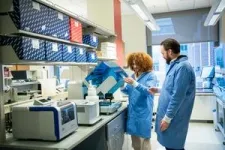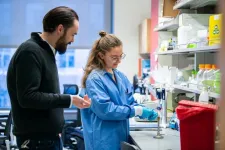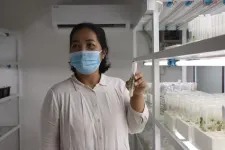(Press-News.org) What do a synthetic chemist, a medical imaging expert, and a neurologist have in common? They’re coming together in the Biomedical Imaging Center at the Beckman Institute for Advanced Science and Technology to develop better diagnostic tools and imaging agents to detect early-stage Alzheimer’s disease and other neurodegenerative diseases.
The dream team
A team led by Liviu M. Mirica along with Wawryzneic “Wawosz” Dobrucki and Dr. Daniel A. Llano received a $3 million grant from the U.S. National Institute on Aging of the National Institutes of Health to develop and test multi-modal imaging agents for the detection of Alzheimer’s disease and related dementias. This grant is one of the first federal grants to bridge Beckman’s Magnetic Resonance Imaging Laboratory and Molecular Imaging Laboratory. They are both part of Beckman's Biomedical Imaging Center.
“I’m really excited about the opportunity to collaborate with different scientists from different fields,” said Mirica, a synthetic chemist and the William H. and Janet G. Lycan Professor of Chemistry in the School of Chemical Sciences at the University of Illinois Urbana-Champaign. His research group specializes in building and characterizing synthetic inorganic molecules in vitro: outside of the body.
Dobrucki, the Neil and Carol Ruzic Scholar for Biomedical and Translational Sciences, is an imaging expert who works extensively with PET scanning in Beckman’s Molecular Imaging Laboratory.
“I’m looking forward to high-resolution imaging of the brain and its structures,” Dobrucki said.
Llano, a professor of molecular and integrated physiology and a physician-surgeon, is a practicing neurologist who sees patients daily and specializes in in vivo brain studies: those inside the body.
“The potential impact that this project will have on Alzheimer’s is what I’m most excited about,” Llano said.
Understanding Alzheimer’s disease
Alzheimer’s disease is a neurodegenerative disease that negatively affects brain function and cognitive abilities. Along with Parkinson’s disease, amyotrophic lateral sclerosis, and other disorders, Alzheimer’s falls under the category of amyloid diseases. Amyloids are small groups of abnormally fibrous or misfolded proteins that do not commonly serve a purpose in the body.
A key marker of Alzheimer’s disease is the presence of amyloid plaques: large buildups of smaller beta-amyloid peptide aggregates. Peptides are short chains of amino acids that eventually create proteins. Neuroinflammation and oxidative stress in the brain are also major markers of Alzheimer’s.
The detection and treatment of neurodegenerative diseases is especially difficult because of the blood-brain barrier, a semipermeable system of blood vessels and capillaries that controls the flow of ions, molecules, and cells between the blood and the brain. To be effective, imaging agents and drug therapies (which are made of molecules or antibodies) need to be able to pass through.
Diagnosis and treatment
Diagnosing Alzheimer’s disease with a high degree of accuracy requires identifying the amyloid aggregates and can only be completed during post-mortem investigation. This creates a need for diagnostic tools that can quickly locate soluble beta-amyloid peptide aggregates and larger amyloid plaques in a living patient.
PET and MRI are two noninvasive imaging methods commonly used in clinical settings. However, no MRI contrast agents that target amyloid aggregates have been developed. The few FDA-approved PET imaging agents are insufficient at detecting small-scale amyloid abnormalities or in some cases, lead to false-positives test results when diagnosing Alzheimer’s.
It's important to develop diagnostic tools to target smaller beta-amyloid peptides and other signs of neuroinflammation and oxidative stress for a variety of reasons, Mirica said. Creating multi-modal tools that can be used for both PET and MRI scans will give researchers a better idea of who is at risk for developing Alzheimer’s, who truly has the disease, and at what stage.
The $3M plan
Mirica, Dobrucki, and Llano will receive the $3 million grant over the course of five years to generate novel dual-purpose imaging agents that can easily pass the blood-brain barrier and are compatible with both PET and MRI scanners.
This will enable the detection of neurodegenerative diseases at earlier stages and “will help tremendously in developing better therapies,” Mirica said.
Brad Sutton, a professor of bioengineering and the technical director of Beckman’s Biomedical Imaging Center, will assist the team by performing in vivo MRI studies. They will then evaluate the imaging agent’s ability as a dual modality diagnostic agent for Alzheimer’s disease and related dementias.
Already, Mirica and his collaborators have developed a series of customized molecules that can cross the blood-brain barrier and help detect both smaller soluble beta-amyloid peptides and larger insoluble amyloids.
They have also developed a copper-based PET imaging agent that led to the successful imaging of amyloid plaques in transgenic Alzheimer’s mice. Looking ahead, the team believes that these agents can be developed to pass through the blood-brain barrier in humans and image multiple markers of Alzheimer’s disease and other neurodegenerative diseases at earlier stages.
Editor's notes
Research reported in this press release was supported by National Institute on Aging of the National Institutes of Health under award number RF1AG083937. The content is solely the responsibility of the authors and does not necessarily represent the official views of the National Institutes of Health.
Mirica is also affiliated with the Carle Illinois College of Medicine and the Department of Bioengineering.
Dobrucki is also an associate professor of bioengineering and the associate head for graduate programs in the Department of Bioengineering.
END
Better together: Beckman imaging facilities share $3 million Alzheimer’s research grant
The grant will help develop diagnostic tools and imaging agents for the early detection of Alzheimer’s disease
2024-02-05
ELSE PRESS RELEASES FROM THIS DATE:
$1.9 million NIH grant to support research on impacts of the microbiome on human health
2024-02-05
UNIVERSITY PARK, Pa. — The bacteria and microorganisms that live within the human body — the microbiota — can impact human health, disease risk and even how the body absorbs medications, but the details of these processes are unclear. To help understand how complex communities of microbes impact human health, the National Institutes of Health’s National Institute of General Medical Science has awarded a 5-year, $1.9 million Maximizing Investigator’s Research Award to Jordan Bisanz, assistant professor of biochemistry and molecular biology in the Penn State Eberly College of Science.
“It is clear that the diversity of microbes in the ...
First representative survey of energy insecurity in New York City
2024-02-05
Researchers at Columbia University Mailman School of Public Health and the New York City Department of Health and Mental Hygiene conducted the first representative survey of energy insecurity and health of New York City residents.
The study’s findings – including that energy insecurity is experienced by approximately 30 percent of New York City (NYC) residents – are published online and in print, in the February issue of the journal Health Affairs. The study and its results help officials understand challenges faced by residents and develop possible interventions and efforts in response.
Results ...
Primary care housing intervention linked to improved patient health outcomes
2024-02-05
Brigham researchers found that participation in a housing program was associated with fewer outpatient visits, improved physical and mental health, and stronger connections to their primary care clinics and care team.
Lack of safe and affordable housing is a critical issue in the United States and creates immense challenges for patients’ health, well-being, and ability to access care. Investigators from Brigham and Women’s Hospital, a founding member of the Mass General Brigham healthcare system, evaluated data from a social ...
MSU researchers find early, promising glioblastoma treatment
2024-02-05
MSU has a satellite uplink/LTN TV studio and Comrex line for radio interviews upon request.
EAST LANSING, Mich. – A team of Michigan State University scientists has unveiled a potential game-changer in the fight against glioblastoma, the most common and currently incurable form of brain cancer.
A team of Michigan State University scientists has unveiled a potential game-changer in the fight against glioblastoma, the most common and currently incurable form of brain cancer.
Their weapon of choice? ...
Are body temperature and depression linked? Science says, yes
2024-02-05
People with depression have higher body temperatures, suggesting there could be a mental health benefit to lowering the temperatures of those with the disorder, a new UC San Francisco-led study found.
The study, publishing today in Scientific Reports, doesn’t indicate whether depression raises body temperature or a higher temperature causes depression. It’s also unknown whether the higher body temperature observed in people with depression reflects decreased ability to self-cool, increased generation of heat from metabolic processes or a combination of both.
Researchers analyzed data from more than 20,000 international ...
Persons diagnosed with PCOS face 8-fold increase in suicide risk
2024-02-05
Embargoed for release until 5:00 p.m. ET on Monday 5 February 2024
Annals of Internal Medicine Tip Sheet
@Annalsofim
Below please find summaries of new articles that will be published in the next issue of Annals of Internal Medicine. The summaries are not intended to substitute for the full articles as a source of information. This information is under strict embargo and by taking it into possession, media representatives are committing to the terms of the embargo not only on their own behalf, but also ...
Mental health care during the COVID-19 era remains inaccessible to many distressed US adults
2024-02-05
U.S. adults experienced considerable psychological distress and adverse mental health effects as a result of the COVID-19 pandemic according to a study at Columbia University Mailman School of Public Health and Columbia University Irving Medical Center. Based on insurance claims, mental health care provider surveys, and electronic health records the research further revealed a decline in in-person outpatient mental health visits during the acute phase of the pandemic. Findings are reported ...
Magnesium protects tantalum, a promising material for making qubits
2024-02-05
UPTON, NY—Scientists at the U.S. Department of Energy’s (DOE) Brookhaven National Laboratory have discovered that adding a layer of magnesium improves the properties of tantalum, a superconducting material that shows great promise for building qubits, the basis of quantum computers. As described in a paper just published in the journal Advanced Materials, a thin layer of magnesium keeps tantalum from oxidizing, improves its purity, and raises the temperature at which it operates as a superconductor. All three may increase tantalum’s ability ...
From Colombia to Laos: protecting crops through nanotechnology
2024-02-05
In a recent breakthrough, DNA sequencing technology has uncovered the culprit behind cassava witches’ broom disease: the fungus genus Ceratobasidium.
The cutting-edge nanopore technology used for this discovery was first developed to track the COVID-19 virus in Colombia, but is equally suited to identifying and reducing the spread of plant viruses. The findings, published in Scientific Reports, will help plant pathologists in Laos, Cambodia, Vietnam and Thailand protect farmers’ valued cassava harvest.
“In Southeast ...
New guideline details acute pain management strategies for adolescent, adult dental patients
2024-02-05
CHICAGO, Feb. 5, 2024 – Nonsteroidal anti-inflammatory drugs (NSAIDs) taken alone or along with acetaminophen are recommended as first-line treatments for managing short-term dental pain in adults and adolescents aged 12 or older, according to a new clinical practice guideline developed by the American Dental Association (ADA), the University of Pittsburgh School of Dental Medicine and the Center for Integrative Global Oral Health at the University of Pennsylvania School of Dental Medicine. The guideline has been endorsed by the ADA and is now available in the February issue of The Journal ...
LAST 30 PRESS RELEASES:
Making lighter work of calculating fluid and heat flow
Normalizing blood sugar can halve heart attack risk
Lowering blood sugar cuts heart attack risk in people with prediabetes
Study links genetic variants to risk of blinding eye disease in premature infants
Non-opioid ‘pain sponge’ therapy halts cartilage degeneration and relieves chronic pain
AI can pick up cultural values by mimicking how kids learn
China’s ecological redlines offer fast track to 30 x 30 global conservation goal
Invisible indoor threats: emerging household contaminants and their growing risks to human health
Adding antibody treatment to chemo boosts outcomes for children with rare cancer
Germline pathogenic variants among women without a history of breast cancer
Tanning beds triple melanoma risk, potentially causing broad DNA damage
Unique bond identified as key to viral infection speed
Indoor tanning makes youthful skin much older on a genetic level
Mouse model sheds new light on the causes and potential solutions to human GI problems linked to muscular dystrophy
The Journal of Nuclear Medicine ahead-of-print tip sheet: December 12, 2025
Smarter tools for peering into the microscopic world
Applications open for funding to conduct research in the Kinsey Institute archives
Global measure underestimates the severity of food insecurity
Child survivors of critical illness are missing out on timely follow up care
Risk-based vs annual breast cancer screening / the WISDOM randomized clinical trial
University of Toronto launches Electric Vehicle Innovation Ontario to accelerate advanced EV technologies and build Canada’s innovation advantage
Early relapse predicts poor outcomes in aggressive blood cancer
American College of Lifestyle Medicine applauds two CMS models aligned with lifestyle medicine practice and reimbursement
Clinical trial finds cannabis use not a barrier to quitting nicotine vaping
Supplemental nutrition assistance program policies and food insecurity
Switching immune cells to “night mode” could limit damage after a heart attack, study suggests
URI-based Global RIghts Project report spotlights continued troubling trends in worldwide inhumane treatment
Neutrophils are less aggressive at night, explaining why nighttime heart attacks cause less damage than daytime events
Menopausal hormone therapy may not pose breast cancer risk for women with BRCA mutations
Mobile health tool may improve quality of life for adolescent and young adult breast cancer survivors
[Press-News.org] Better together: Beckman imaging facilities share $3 million Alzheimer’s research grantThe grant will help develop diagnostic tools and imaging agents for the early detection of Alzheimer’s disease




